Is it or isn't it?
Confusion over ground water contamination in
Chunnakam:
by Dhaneshi Yatawara
Two separate investigations were carried out earlier to determine
ground water contamination in Chunnakam, which led to confusion. The
reports came out in April with one report that ground water was not so
badly contaminated and the other claiming the spread of contamination
had reduced. However, investigations by the expert committee appointed
by the Ministry of Urban Development, Water Supply and Drainage revealed
that the ground water in the area surrounding the Chunnakam power plant
was contaminated with oil and grease and was unsuitable for use.
 |
|
School children drinking
water from a water tank provided by the state |
Now the committee appointed by the Jaffna Municipal Council states
that there was no contamination whatsoever. Villagers are in a quandary,
because as far as they are concerned the water they consume tastes
different.
Ground water is the main source of drinking water in many areas in
the North . Villagers are solely dependent on this source for all their
water requirements. When this water is contaminated, villagers have
nowhere to go to and have to trek miles to get clean drinking water.
Meanwhile, it was found that ground water in the Vallikamam area was
polluted due to contamination.
Monitoring
The Central Environment Authority (CEA) was monitoring the situation
after receiving complaints that the ground water supply was not fit for
drinking purposes. However, after care ful monitoring any spread of
contami nation has been ruled out. "Following the initial tests, the CEA
continued to carry out tests and showed that pollution had stopped
spreading," CEA Chairman, Professor Lal Dharmasiri said.
"Our officers are continuously monitoring to ascertain whether the
concentration of pollutants were declining," Prof. Dharmasiri explained.
More than a quarter million people living in Chunnakam are affected
by this situation. It is the Vallikamam area that is badly affected.
Meanwhile, environmentalists and medical experts warned that due to
seepage of petroleum effluents there was bound to be heavy contamination
of ground water supplies.
Chunnakam, Thellipalay, Ezhalai, Kumbalavalai, Kattuvan, Mallakam,
Uduvil, Inuvil and Thavaddy areas in Valikamam were affected due to
contamination. Now there is a fear that contamination may have spread to
Kokuvil too. It has been found that even school wells are affected apart
from residences. Minister of Urban Development, Water Supply and
Drainage, Rauff Hakeem said that according to the initial report by the
Ministry's expert committee, an area of up to two kilometres north of
the Chunnakam power plant has been contaminated with oil and grease.
Minister Hakeem said that a total of 150 wells were tested. Of these,
109 wells (73%) showed higher levels of oil and grease than the standard
amount, while seven (4%) had oil levels below the limit and 34 wells
(23%) were not contaminated.
Petroleum effluents
Environmentalists and local medical experts stress that there is
sufficient evidence that petroleum effluents that contaminate ground
water is seeping from the oil pool of the previously state-run power
plant, located in the area owned by the Ceylon Electricity Board.
 |
|
An agro well |
The power plant was subsequently closed a few years ago and no one
knew what happened to the petroleum effluents in the oil pool. Initially
allegations were raised against the Northern Power' power plant as being
the source of contamination.
The management of 'Northern Power' denied the allegations pointing
accusing fingers at the abandoned petroleum pool of the previously
state- run power plant. The National Water Supply and Drainage Board and
the Jaffna Municipal Council have ensured that the people in the area
receive clean drinking water. 225,000 litres of water is transported in
six bowsers on a daily basis. The situation is sensitive in Vallikamam,
as lack of water for daily needs has become a huge problem for
residents.
The authorities were notified of the situation in late January this
year, when people raised their voice demanding a solution, the
Government through the District Secretariat then began supplying fresh,
clean water to the affected areas in bowsers. however, they say they are
not used to getting water from bowsers and tanks. According to the
Jaffna District Secretary, Suntharam Aruminayaham water tanks are filled
daily and people store water in large containers. "Daily over 250 water
tanks are filled," Aruminayaham said. These large tanks are set up by
the District Secretariat to provide water for the people.
Still there is a lack of water for the villagers daily needs. It has
been found that it's not only crude oil pollutants that has seeped into
the well water. Research carried out by Dr. Thushyanthy Mikunthan, Dr.
Meththika Vithanage, Dr. S. Pathmarajah, Mr. Ranjith Ariyaratne and Dr.
H. Manthrithilake also identified high levels of nitrates in the wells,
particularly the agro wells - known as 'andiya' wells with its unique
lever structure. The entire ground water network of the Jaffna peninsula
has been affected by salt water intrusion and polluted by agro chemicals
over the years.It is also reported that immediate steps were being taken
to bring the situation under control.
The Ministry of Environment was urgently looking into the matter.
People need a permanent solution before the situation turns into another
Rathupaswala incident. |

